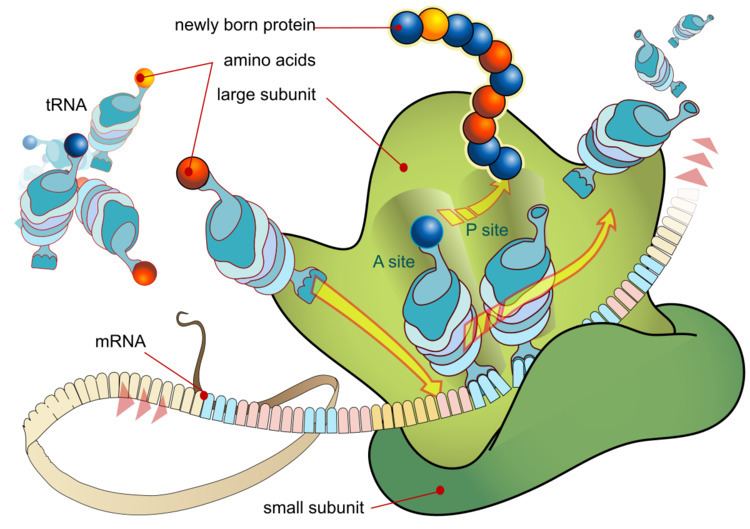A protein synthesis inhibitor is a substance that stops or slows the growth or proliferation of cells by disrupting the processes that lead directly to the generation of new proteins.
While a broad interpretation of this definition could be used to describe nearly any antibiotic, in practice, it usually refers to substances that act at the ribosome level (either the ribosome itself or the translation factor), taking advantages of the major differences between prokaryotic and eukaryotic ribosome structures.
Toxins such as ricin also function via protein synthesis inhibition. Ricin acts at the eukaryotic 60S.
Examples:
NeomycinGeneticin, also called G418In general, protein synthesis inhibitors work at different stages of prokaryotic mRNA translation into proteins, like initiation, elongation (including aminoacyl tRNA entry, proofreading, peptidyl transfer, and ribosomal translocation) and termination:
Rifamycin inhibits prokaryotic DNA transcription into mRNA by inhibiting DNA-dependent RNA polymerase by binding its beta-subunit.Linezolid acts at the initiation stage, probably by preventing the formation of the initiation complex, although the mechanism is not fully understood.Tetracyclines and Tigecycline (a glycylcycline related to tetracyclines) block the A site on the ribosome, preventing the binding of aminoacyl tRNAs.Aminoglycosides, among other potential mechanisms of action, interfere with the proofreading process, causing increased rate of error in synthesis with premature termination.Chloramphenicol blocks the peptidyl transfer step of elongation on the 50S ribosomal subunit in both bacteria and mitochondria.Macrolides (as well as inhibiting ribosomal translocation and other potential mechanisms) bind to the 50s ribosomal subunits, inhibiting peptidyl transfer.Quinupristin/dalfopristin act synergistically, with dalfopristin, enhancing the binding of quinupristin, as well as inhibiting peptidyl transfer. Quinupristin binds to a nearby site on the 50S ribosomal subunit and prevents elongation of the polypeptide, as well as causing incomplete chains to be released.Macrolides, clindamycin and aminoglycosides (with all these three having other potential mechanisms of action as well), have evidence of inhibition of ribosomal translocation.Fusidic acid prevents the turnover of elongation factor G (EF-G) from the ribosome.Macrolides and clindamycin (both also having other potential mechanisms) cause premature dissociation of the peptidyl-tRNA from the ribosome.Puromycin has a structure similar to that of the tyrosinyl aminoacyl-tRNA. Thus, it binds to the ribosomal A site and participates in peptide bond formation, producing peptidyl-puromycin. However, it does not engage in translocation and quickly dissociates from the ribosome, causing a premature termination of polypeptide synthesis.Streptogramins also cause premature release of the peptide chain.RetapamulinMupirocinFusidic acidThe following antibiotics bind to the 30S subunit of the ribosome:
Aminoglycosides TetracyclinesThe following antibiotics bind to the 50S ribosomal subunit:
ChloramphenicolErythromycinClindamycinLinezolid (an oxazolidinone)TelithromycinStreptograminsRetapamulin
